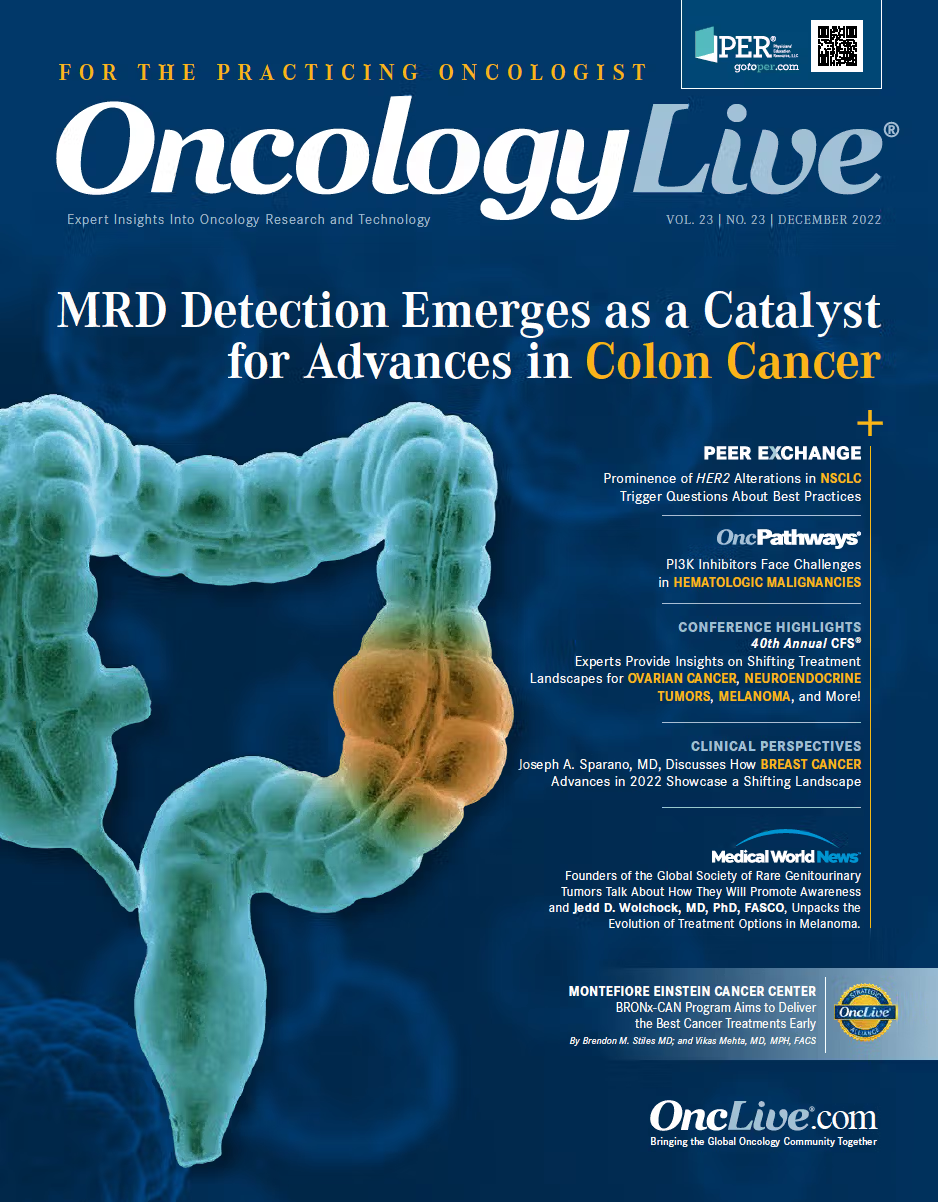Publication
Article
Tremelimumab Plus Durvalumab Receives Go-ahead for Treatment of HCC
Author(s):
Ghassan K. Abou-Alfa, MD, discusses the administration of tremelimumab plus durvalumab in hepatocellular carcinoma and where the combination will fit in the treatment paradigm.
Ghassan K. Abou-Alfa, MD

The approval of tremelimumab-actl (Imjudo) in combination with durvalumab (Imfinzi) for adult patients with unresectable hepatocellular carcinoma (HCC) expands frontline treatment options, joining FDA-approved first-line agents bevacizumab (Avastin) plus atezolizumab (Tecentriq), sorafenib (Nexavar), and lenvatinib (Lenvima).
The FDA approved the combination on October 21, 2022, based on data from the phase 3 HIMALAYA trial (NCT03298451), which compared the combination with sorafenib as the primary end point. Patients in the tremelimumab plus durvalumab arm (n = 393) achieved an overall response rate of 20.1% compared with 5.1% in the sorafenib arm (n = 389). The median duration of response was 22.3 months vs 18.4 months, respectively.1
The risk of death was reduced by 23% with the combination vs sorafenib (HR, 0.78; 95% CI, 0.66-0.92; P = .0035). The median progression-free survival was 3.8 months vs 4.1 months, respectively (stratified HR, 0.90; 95% CI, 0.77-1.05).1
“It’s a great outcome in a positive direction,” Ghassan K. Abou-Alfa, MD, said. “We now have a longer survival [at a median of] approximately 16.5 months [and] based on the HIMALAYA data, one-third of patients were alive at 3 years.”
In an interview with OncologyLive®, Abou-Alfa, a medical oncologist at Memorial Sloan Kettering Cancer Center in New York, New York, discussed the administration of the combination and where it will fit in the treatment paradigm.
Please discuss the significance of this approval.
The combination of 2 dual checkpoint inhibitors, tremelimumab plus durvalumab, for patients with advanced liver cancer and the need for systemic therapy is a great add-on of therapy that we’re delighted for. It is the easiest to manage from the patient perspective; tremelimumab is given once and durvalumab is given [intravenously] once per month. Patients can now [have] greater control of their schedule, and not necessarily going back and forth for therapy or taking pills.
Please discuss the mechanism of action of this combination.
PD-1 [and] PD-L1 are like nice chairs offered by the cancer at the cell membrane level that offer some way for the T cells coming from our lymph nodes to sit down, relax, and not touch the cancer. Interestingly, durvalumab, as an anti–PD-L1 [therapy], kicks the chair out so the T cells reach the cancer, attack it, and act on it as a foreign body. [For] this action to happen, [it relies on a signal from further up on the] chain of command, which starts at the lymph node.
This is where CTLA-4 comes into play. [To trigger] CD86 activity, CTLA-4 needs [to be blocked] and tremelimumab will take away CTLA-4, permit CD86 to do its job, and send the message to the anti PD–L1 durvalumab down there.
A key element of this combination is that the anti–CTLA-4 [activity] of tremelimumab is powerful and 3 times more potent than CD28 and that’s why you give the dose once.
What were the key efficacy data from HIMALAYA?
The combination of durvalumab plus tremelimumab, which we call the STRIDE regimen, showed an improvement in outcomes and the median [overall] survival was 16.43 months compared with 13.77 months with sorafenib. This was clinically and statistically significant.
We know that the priming of the T cells takes awhile. As such, the meeting of the [survival curves] should not be the focus [of the data] because as time goes on, and more T cells are [primed to] fight the cancer, we’re going to see continued separation that will diverted the median survival at the 3 years by approximately 30% with [STRIDE] compared with sorafenib.
This is why we continue to hear details of [long curves]. [This is because although] the median survival is positive [it] is not the only story. We’re almost reading a new language about the priming and the activity of the checkpoint inhibitors, [but] we don’t have all the information, which is important to remember.
What common toxicities are important to mention with this combination?
The combination has been well tolerated. Understandably, all therapies will cause certain adverse events, but thankfully we did not have any serious [unexpected] concerns. The grade 3 and 4 toxicities with the combination were limited [and] subtle. [For example,] rate of diarrhea was approximately 4% and 5% for liver function tests. There is a margin of tolerance for the [regimen] and the classic adverse events that you can expect to see with checkpoint inhibitors; for example, joint pains, rashes, or diarrhea will occur.
How do you see this combination fitting into the current treatment paradigm for this population?
Twenty years ago, there was barely any choice of therapy…now we have many treatment choices. This is great news for the patients. On the one hand, there are a lot of options. On the other hand, the comparison [of agents] and decision-making should be a very thought out [process].
We have 4 choices of first-line therapies. We have the tyrosine kinase inhibitors [TKIs] sorafenib [and] lenvatinib, the combination of atezolizumab plus bevacizumab as a checkpoint inhibitor plus anti-VEGF, and now we have tremelimumab plus durvalumab. When it comes to the checkpoint inhibitor combination, they are better than the single-agent TKIs. The question is how to pick and choose between the 2. It becomes a decision that’s based on data not on direct comparison because a direct comparison never happened.
[When choosing a treatment, we] want to make sure that [patients] have been responsive to therapy and benefit from it. The important component here is when we compare data from different clinical trials, we must investigate the demographics of the populations.
[For example,] in [a study of] atezolizumab plus bevacizumab approximately 50% of patients had hepatitis B [infection], but in the HIMALAYA study of durvalumab/tremelimumab, approximately 30% had hepatitis B. The nice thing about the durvalumab/tremelimumab [combination] is it is very straightforward to give, but with atezolizumab/bevacizumab, you perform an endoscopy scope on the patients [as it] is critical. [For patients] for whom the endoscopy might be a little bit of a challenge...we might decide otherwise.
It’s a great delight to see an approval of a combination of dual checkpoint inhibitors for patients with advanced liver cancer, but the unmet need for this population is what we all aspire for—cure.
Reference
FDA approves tremelimumab in combination with durvalumab for unresectable hepatocellular carcinoma. FDA. October 24, 2022. Accessed November 4, 2022. bit.ly/3NzocGO










